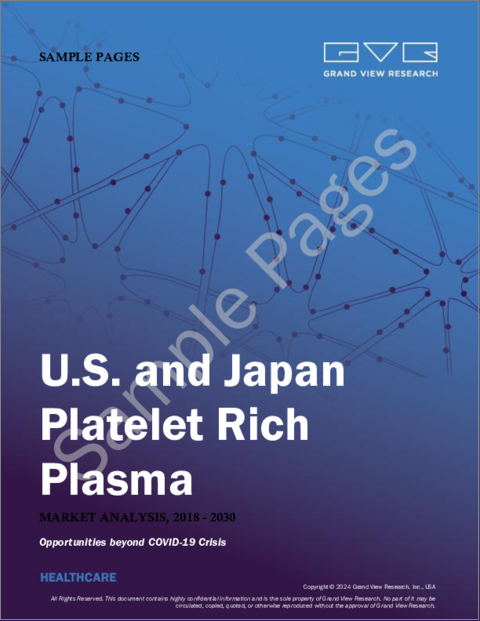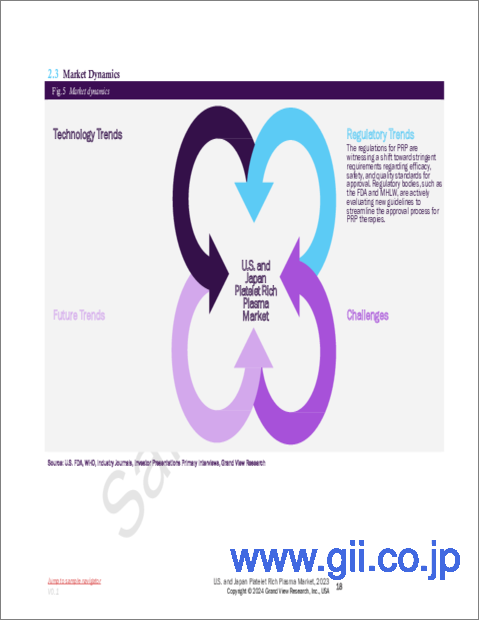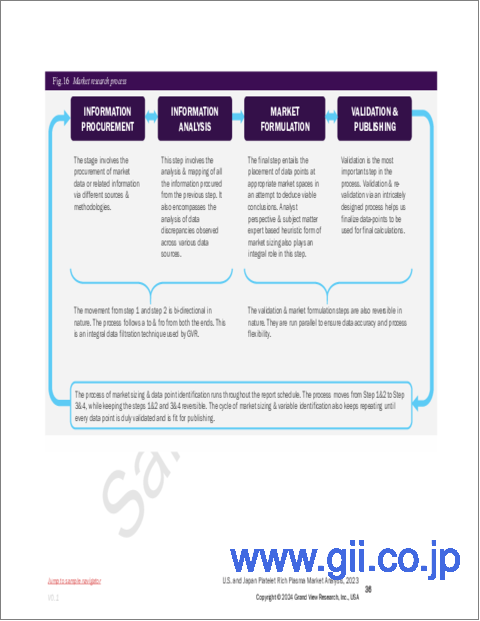|
|
市場調査レポート
商品コード
1405908
米国と日本の多血小板血漿市場規模、シェア、動向分析レポート:タイプ別、用途別、最終用途別、国別、セグメント予測、2024年~2030年U.S. And Japan Platelet Rich Plasma Market Size, Share & Trends Analysis Report By Type, (Pure Platelet Rich Plasma, Leukocyte Rich Platelet Rich Plasma), By Application, By End-use, By Country, And Segment Forecasts, 2024 - 2030 |
||||||
カスタマイズ可能
|
|||||||
| 米国と日本の多血小板血漿市場規模、シェア、動向分析レポート:タイプ別、用途別、最終用途別、国別、セグメント予測、2024年~2030年 |
|
出版日: 2023年12月28日
発行: Grand View Research
ページ情報: 英文 125 Pages
納期: 2~10営業日
|
全表示
- 概要
- 図表
- 目次
米国と日本の多血小板血漿市場の成長と動向:
Grand View Research, Inc.の最新レポートによると、米国と日本の多血小板血漿市場規模は、2024年から2030年にかけて10.15%のCAGRを記録し、2030年までに3億4,845万米ドルに達すると予測されています。
米国と日本の多血小板血漿(PRP)市場は、整形外科疾患やスポーツ傷害の発生率の増加、美容外科手術の増加、多血小板血漿の医療用途の拡大によって牽引されています。さらに、多血小板血漿を用いた創傷治癒に関するエビデンスに基づく研究の増加が、市場全体の成長をさらに促進しています。
筋骨格系疾患、整形外科疾患、スポーツ傷害の治療における多血小板血漿製品の応用は、近年より普及しています。PRP中の成長因子の濃度を高めることで治癒プロセスを促進できる可能性があることが、いくつかの調査研究で観察されています。PRPは、幹細胞や足場とともに、この分野における自家製品の主要な供給源であり、治癒プロセスの真の前駆体であることが証明されています。米国CDCのデータによると、米国におけるスポーツへの参加は増加の一途をたどっています。米国では、およそ3,000万人の子供と青少年がスポーツに参加しており、若いアスリートの間でスポーツ傷害のリスクが高まっています。したがって、整形外科疾患やスポーツ傷害の発生率の増加は、多血小板血漿治療手技の需要にプラスの影響を与えます。
美容外科手術の増加は多血小板血漿製品の需要を促進します。例えば、ASPSによると、化粧品におけるPRPの使用は過去4年間で25%増加しました。さらに、米国と日本では美容外科手術の採用が増加しており、調査期間中、市場に有利な機会を提供すると期待されています。米国顔面形成再建外科学会(AAFPRS)の年次調査によると、2018年に注射剤が顔面形成外科医によって最も採用された治療オプションとなった。美容手術や低侵襲処置に対する米国人の多額の支出も、多血小板血漿市場を牽引しています。Aesthetic Societyのデータによると、米国人は2022年に低侵襲手術と美容整形手術に約118億米ドルを支出し、前年比2%増を報告しました。
多血小板血漿の有用性は、美容と皮膚科で人気を集めています。市販されているシステムは、すぐに使える無菌PRP懸濁液を提供するが、これらの製品に関連する高コストが、ヘルスケア専門家がPRPキットを大規模に展開することを困難にしています。他の治療法と比較してPRP注入の費用が高いことは、患者や臨床医にとって大きな懸念です。さらに、PRP療法を支持するエビデンスが不足しているため、保険はこれらの製品をカバーしていないです。米国整形外科学会は、PRPの結果は治癒能力によって患者ごとに異なると述べています。したがって、これらの製品に関連するコストは、予測期間中の市場を阻害する可能性が高いです。
米国と日本の多血小板血漿市場レポートハイライト:
- タイプ別では、純多血小板血漿セグメントが、その利点と様々な治療領域での用途拡大による純多血小板血漿の高い採用率により、2023年に51.24%の収益シェアで市場を独占しました。
- 用途別では、その他のセグメントが予測期間中に最も速いCAGRで成長すると予測されています。
- 最終用途に基づくと、病院セグメントが2023年に市場で最大の収益シェアを占めました。美容目的でのPRP治療の優先度が高まっていることが、このセグメントの成長を促進する重要な要因です。診療所セグメントは、診療所数の増加と医療ツーリズムの増加により、予測期間中に最も速いCAGRで成長する見込みです。
- 米国が市場を独占しているのは、規制当局の支援や、新規PRP調製システムの開発に注力する多くの大手メーカーの現地進出などの要因によるものです。
目次
第1章 調査手法と範囲
第2章 エグゼクティブサマリー
第3章 米国と日本の多血小板血漿市場の変数、動向、および範囲
- 米国と日本の多血小板血漿市場系統の見通し
- 親市場の見通し
- アンシラリーマーケット
- 市場力学
- 市場促進要因分析
- 市場抑制要因分析
- 米国と日本の多血小板血漿市場分析ツール
- ポーターのファイブフォース分析
- PESTLE分析
- 主な意見の視点分析
- 市場機会分析
- 購入者の認識調査
- 主な意見の視点分析
第4章 米国と日本の多血小板血漿市場 - タイプ別セグメント分析、2018年~2030年
- 米国と日本の多血小板血漿(Prp)市場:タイプの変動分析
- 純PRP
- 多白血球rp
- その他
第5章 米国と日本の多血小板血漿市場 - 用途別セグメント分析、2018年~2030年
- 米国と日本の多血小板血漿(Prp)市場:用途変動分析
- 整形外科
- その他
第6章 米国と日本の多血小板血漿市場 - 最終用途別セグメント分析、2018年~2030年
- 米国と日本の多血小板血漿(Prp)市場:最終用途変動分析
- 病院
- クリニック
- その他
第7章 米国と日本の多血小板血漿(Prp)市場:国推定・動向分析
- 米国
- 主要な国の動向
- 米国の多血小板血漿
- 競合シナリオ
- 規制の枠組み
- 償還シナリオ
- 日本
第8章 競合情勢
- 企業の分類
- Participants'Overview
- 財務実績
- 製品のベンチマーク
- 企業の市場シェア分析、2023年
- 戦略マッピング
- 拡大
- コラボレーション
- 新製品の発売
- 買収
- その他
- List Of Emerging Companies
- Johnson & Johnson Services, Inc.
- Arthrex, Inc.
- EmCyte Corporation
- Dr. PRP USA LLC
- Juventix Regenerative Medical, LLC
- Terumo Corporation
- Zimmer Biomet
- Stryker
- Apex Biologix
- Celling Biosciences, Inc.
- Factor Medical, Inc.
- CAREstream America
- Royal Biologics.
第9章 結論
List of Tables
- Table 1 List of secondary sources
- Table 2 List of abbreviation
- Table 3 Growth factors involved in stages of wound healing
- Table 4 Growth factors involved in wound healing with their origin
- Table 5 Use of PRP in wound management
- Table 6 Randomized controlled trials: PRP-based wound healing
- Table 7 Some of the prominent manufacturers operating in pure PRP market
- Table 8 Some of the hospitals offering PRP treatment for different applications
- Table 9 Some of the PRP service providers in Japan
- Table 10 Key companies undergoing expansions
- Table 11 Key companies undergoing collaborations
- Table 12 Key companies undergoing new product launches
- Table 13 Key companies undertaking acquisitions
- Table 14 Key companies undertaking other activities
- Table 15 Key companies undertaking other activities
- Table 16 China immunohistochemistry market, by type, 2018 - 2030 (USD Million)
- Table 17 China immunohistochemistry market, by application, 2018 - 2030 (USD Million)
- Table 18 China immunohistochemistry market, by end use, 2018 - 2030 (USD Million)
- Table 19 Japan immunohistochemistry market, by type, 2018 - 2030 (USD Million)
- Table 20 Japan immunohistochemistry market, by application, 2018 - 2030 (USD Million)
- Table 21 Japan immunohistochemistry market, by end use, 2018 - 2030 (USD Million)
List of Figures
- Fig. 1 U.S. and Japan Platelet rich plasma market segmentation
- Fig. 2 Market research process
- Fig. 3 Data triangulation techniques
- Fig. 4 Primary research pattern
- Fig. 5 Value chain based sizing & forecasting
- Fig. 6 QFD modelling for market share assessment
- Fig. 7 Market formulation & validation
- Fig. 8 Market snapshot
- Fig. 9 Type and application segment snapshot
- Fig. 10 End-use segment snapshot
- Fig. 11 Competitive landscape snapshot
- Fig. 12 Global platelet rich plasma (PRP) market value, 2023 (USD Million)
- Fig. 13 Market dynamics
- Fig. 14 Prevalence rate of arthritis in the U.S. adults, diagnosed and projected cases
- Fig. 15 Incidence of arthritis in U.S., by age
- Fig. 16 Benefits of PRP treatment in cosmetic facial procedures
- Fig. 17 Common minimal invasive procedures in 2019, U.S.
- Fig. 18 Porter's five forces analysis
- Fig. 19 PESTLE analysis
- Fig. 20 Platelet rich plasma market: End-use outlook and key takeaways
- Fig. 21 U.S. and Japan Platelet rich plasma (PRP) market: Type movement analysis
- Fig. 22 Pure PRP market estimates and forecast, 2018 - 2030 (USD Million)
- Fig. 23 Platelet Rich Plasma (PRP) market estimates and forecast for orthopedics, 2018 - 2030 (USD Million)
- Fig. 24 Platelet Rich Plasma (PRP) market estimates and forecast for sports medicine, 2018 - 2030 (USD Million)
- Fig. 25 Platelet Rich Plasma (PRP) market estimates and forecast for spine, 2018 - 2030 (USD Million)
- Fig. 26 Platelet Rich Plasma (PRP) market estimates and forecast for trauma, 2018 - 2030 (USD Million)
- Fig. 27 Platelet Rich Plasma (PRP) market estimates and forecast for foot and ankle, 2018 - 2030 (USD Million)
- Fig. 28 Platelet Rich Plasma (PRP) market estimates and forecast for joint reconstruction, 2018 - 2030 (USD Million)
- Fig. 29 Leukocyte-rich PRP market estimates and forecast, 2018 - 2030 (USD Million)
- Fig. 30 Platelet Rich Plasma (PRP) market estimates and forecast for orthopedics, 2018 - 2030 (USD Million)
- Fig. 31 Platelet Rich Plasma (PRP) market estimates and forecast for sports medicine, 2018 - 2030 (USD Million)
- Fig. 32 Platelet Rich Plasma (PRP) market estimates and forecast for spine, 2018 - 2030 (USD Million)
- Fig. 33 Platelet Rich Plasma (PRP) market estimates and forecast for trauma, 2018 - 2030 (USD Million)
- Fig. 34 Platelet Rich Plasma (PRP) market estimates and forecast for foot and ankle , 2018 - 2030 (USD Million)
- Fig. 35 Platelet Rich Plasma (PRP) market estimates and forecast for joint reconstruction , 2018 - 2030 (USD Million)
- Fig. 36 Others PRP market estimates and forecast for others, 2018 - 2030 (USD Million)
- Fig. 37 U.S. and Japan Platelet Rich Plasma (PRP) market estimates and forecast for orthopedics, 2018 - 2030 (USD Million)
- Fig. 38 U.S. and Japan Platelet Rich Plasma (PRP) market estimates and forecast for sports medicine, 2018 - 2030 (USD Million)
- Fig. 39 U.S. and Japan Platelet Rich Plasma (PRP) market estimates and forecast for spine, 2018 - 2030 (USD Million)
- Fig. 40 U.S. and Japan Platelet Rich Plasma (PRP) market estimates and forecast for trauma, 2018 - 2030 (USD Million)
- Fig. 41 U.S. and Japan Platelet Rich Plasma (PRP) market estimates and forecast for foot and ankle, 2018 - 2030 (USD Million)
- Fig. 42 U.S. and Japan Platelet Rich Plasma (PRP) market estimates and forecast for joint reconstruction, 2018 - 2030 (USD Million)
- Fig. 43 U.S. and Japan Platelet rich plasma (PRP) market: Application outlook and key takeaways
- Fig. 44 U.S. and Japan Platelet rich plasma (PRP) market: Application movement analysis
- Fig. 45 Platelet Rich Plasma (PRP) market estimates and forecast for orthopedics, 2018 - 2030 (USD Million)
- Fig. 46 Platelet Rich Plasma (PRP) market estimates and forecast for sports medicine, 2018 - 2030 (USD Million)
- Fig. 47 Platelet Rich Plasma (PRP) market estimates and forecast for spine, 2018 - 2030 (USD Million)
- Fig. 48 Platelet Rich Plasma (PRP) market estimates and forecast for trauma, 2018 - 2030 (USD Million)
- Fig. 49 Platelet Rich Plasma (PRP) market estimates and forecast for foot and ankle, 2018 - 2030 (USD Million)
- Fig. 50 Platelet Rich Plasma (PRP) market estimates and forecast for joint reconstruction, 2018 - 2030 (USD Million)
- Fig. 51 Platelet Rich Plasma (PRP) market estimates and forecast for others, 2018 - 2030 (USD Million)
- Fig. 52 Percentage of adult population dental clinic visits, U.S.
- Fig. 53 U.S. and Japan Platelet rich Plasma (PRP) market: End-use outlook and key takeaways
- Fig. 54 U.S. and Japan Platelet rich plasma (PRP) market: End-use movement analysis
- Fig. 55 Platelet rich plasma (PRP) market for hospitals, 2018 - 2030 (USD Million)
- Fig. 56 Platelet rich plasma (PRP) market for clinics, 2018 - 2030 (USD Million)
- Fig. 57 Platelet rich plasma (PRP) market for other end uses, 2018 - 2030 (USD Million)
- Fig. 58 Key country dynamics
- Fig. 59 U.S. Platelet Rich Plasma (PRP) market estimates and forecasts, 2018 - 2030 (USD Million)
- Fig. 60 Key country dynamics
- Fig. 61 Japan Platelet Rich Plasma (PRP) market estimates and forecast, 2018 - 2030 (USD Million)
U.S. And Japan Platelet Rich Plasma Market Growth & Trends:
The U.S. and Japan platelet rich plasma market size is anticipated to reach USD 348.45 million by 2030, registering a CAGR of 10.15% from 2024 to 2030, according to a new report by Grand View Research, Inc. The U.S. and Japan platelet rich plasma (PRP) market is driven by increasing incidence of orthopedic disorders and sports injuries, growing number of cosmetic surgeries, and expanding medical application of platelet rich plasma. Moreover, increasing evidence-based studies for platelet rich plasma-based wound healing are further propelling growth of overall the market.
The application of platelet rich plasma products in treatment of musculoskeletal conditions, orthopedic disorders, and sports injuries has become more prevalent over recent years. Several research studies have observed that an increased concentration of growth factors in PRP can potentially accelerate healing process. PRP has proven to be a major source of autologous products in the field and a true precursor for healing process along with stem cells & scaffold. According to U.S. CDC data, participation of individuals in sports in the U.S. is continuously rising. Around 30 million children and adolescents in the U.S. participate in sports, which increases risk of sports injuries among young athletes. Therefore, the rise in incidence of orthopedic disorders and sports injuries positively impacts demand for platelet rich plasma treatment procedures.
An increase in cosmetic surgeries drives demand for platelet rich plasma products. For instance, according to the ASPS, a 25% rise in use of PRP in cosmetics was observed in the past 4 years. Moreover, increasing adoption of cosmetic surgeries in the U.S. and Japan is expected to offer lucrative opportunities for the market during the study period. As per an annual survey of the American Academy of Facial Plastic and Reconstructive Surgery (AAFPRS), injectables became the most adopted treatment option by facial plastic surgeons in 2018. Large spending by Americans on cosmetic surgeries and minimally invasive procedures also drives platelet rich plasma market. According to the Aesthetic Society data, Americans spent approximately USD 11.8 billion on minimally invasive and cosmetic surgery procedures in 2022, reporting an increase of 2% over previous year.
The utility of platelet rich plasma is gaining popularity in aesthetics and dermatology. The commercially marketed systems provide ready-to-apply sterile PRP suspensions; however, high cost associated with these products makes it difficult for healthcare professionals to deploy PRP kits on a large scale. The higher cost of PRP injection as compared to other treatments is a major concern for patients and clinicians. Moreover, insurance policies do not cover these products due to a lack of supportive evidence for PRP therapies. The American Academy of Orthopedic Surgeons stated that PRP results differ from patient to patient, depending on healing capabilities. Thus, cost associated with these products is likely to impede the market over the forecast period.
U.S. And Japan Platelet Rich Plasma Market Report Highlights:
- Based on type, the pure platelet rich plasma segment dominated the market with a revenue share of 51.24% in 2023 owing to high adoption of pure platelet rich plasma because of its advantages and expanding applications across various therapeutic areas
- Based on application, the other segment is expected to grow at fastest CAGR over the forecast period
- Based on end-use, the hospitals segment held the largest revenue share of the market in 2023. Increasing priority of PRP treatment for aesthetic purposes is a significant factor driving growth of this segment. Clinics segment is expected to grow at fastest CAGR over forecast period owing to rising number of clinics and growing medical tourism
- U.S. dominated the market owing to factors such as supportive regulatory authorities and local presence of many leading manufacturers that focus on developing novel PRP preparation systems
Table of Contents
Chapter 1 Methodology And Scope
- 1.1 Market Segmentation
- 1.1.1 Regional Scope
- 1.1.2 Market Definitions
- 1.1.3 Estimates And Forecast Timeline
- 1.2 Objectives
- 1.2.1 Objective - 1
- 1.2.2 Objective - 2
- 1.2.3 Objective - 3
- 1.3 Research Methodology
- 1.4 Information Procurement
- 1.4.1 Purchased Database
- 1.4.2 Gvr's Internal Database
- 1.4.3 Secondary Sources
- 1.4.4 Primary Research
- 1.4.5 Details Of Primary Research
- 1.5 Information Or Data Analysis
- 1.5.1 Data Analysis Models
- 1.6 Market Formulation & Validation
- 1.7 Model Details
- 1.7.1 Commodity Flow Analysis
- 1.7.1.1 Approach 1: Commodity Flow Approach
- 1.7.1.2 Approach 2: Country Wise Market Estimation Using Bottom-Up Approach
- 1.7.1 Commodity Flow Analysis
- 1.8 List Of Secondary Sources
- 1.9 List Of Abbreviations
Chapter 2 Executive Summary
- 2.1 Market Snapshot
- 2.2 Type And Application Segment Snapshot
- 2.3 End-Use Segment Snapshot
- 2.4 Competitive Landscape Snapshot
Chapter 3 U.S. And Japan Platelet Rich Plasma Market Variables, Trends, And Scope
- 3.1 U.S. And Japan Platelet Rich Plasma Market Lineage Outlook
- 3.1.1 Parent Market Outlook
- 3.1.2 Ancillary Market
- 3.2 Market Dynamics
- 3.2.1 Market Driver Analysis
- 3.2.1.1 Rise In Incidence Of Orthopedic Disorders And Sports Injuries
- 3.2.1.2 Increasing Cosmetic Surgeries
- 3.2.1.3 Expanding Medical Applications Of Prp
- 3.2.1.4 Increasing Evidence-Based Studies For Prp-Based Wound Healing
- 3.2.2 Market Restraint Analysis
- 3.2.2.1 High Costs Associated With Prp Products
- 3.2.1 Market Driver Analysis
- 3.3 U.S. And Japan Platelet Rich Plasma Market Analysis Tools
- 3.3.1 Porter's Five Forces Analysis
- 3.3.2 Pestle Analysis
- 3.3.3 Key Opinion Perspective Analysis
- 3.3.4 Market Opportunity Analysis
- 3.3.5 Buyer Perception Studies
- 3.3.6 Key Opinion Perspective Analysis
Chapter 4 U.S. And Japan Platelet Rich Plasma Market - Segment Analysis, By Type, 2018 - 2030 (USD Million)
- 4.1 U.S. And Japan Platelet Rich Plasma (Prp) Market: Type Movement Analysis
- 4.1.1 Pure Prp
- 4.1.1.1 Orthopedics
- 4.1.1.1.1 Sports Medicine
- 4.1.1.1.2 Spine
- 4.1.1.1.3 Trauma
- 4.1.1.1.4 Foot And Ankle
- 4.1.1.1.5 Joint Reconstruction
- 4.1.2 Leukocyte-Rich Rich Prp
- 4.1.2.1 Orthopedics
- 4.1.2.1.1 Sports Medicine
- 4.1.2.1.2 Spine
- 4.1.2.1.3 Trauma
- 4.1.2.1.4 Foot And Ankle
- 4.1.2.1.5 Joint Reconstruction
- 4.1.3 Others
- 4.1.3.1 Orthopedics
- 4.1.3.1.1 Sports Medicine
- 4.1.3.1.2 Spine
- 4.1.3.1.3 Trauma
- 4.1.3.1.4 Foot And Ankle
- 4.1.3.1.5 Joint Reconstruction
- 4.1.1 Pure Prp
Chapter 5 U.S. And Japan Platelet Rich Plasma Market - Segment Analysis, By Application, 2018 - 2030 (USD Million)
- 5.1 U.S. And Japan Platelet Rich Plasma (Prp) Market: Application Movement Analysis
- 5.1.1 Orthopedics
- 5.1.1.1 Sports Medicine
- 5.1.1.2 Spine
- 5.1.1.3 Trauma
- 5.1.1.4 Foot And Ankle
- 5.1.1.5 Joint Reconstruction
- 5.1.2 Others
- 5.1.1 Orthopedics
Chapter 6 U.S. And Japan Platelet Rich Plasma Market - Segment Analysis, By End Use, 2018 - 2030 (USD Million)
- 6.1 U.S. And Japan Platelet Rich Plasma (Prp) Market: End-Use Movement Analysis
- 6.1.1 Hospitals
- 6.1.2 Clinics
- 6.1.3 Others
Chapter 7 U.S. And Japan Platelet Rich Plasma (Prp) Market: Country Estimates And Trend Analysis
- 7.1. U.S.
- 7.1.1 Key Country Dynamics
- 7.1.2 U.S. Platelet Rich Plasma (Prp) Market Estimates And Forecasts, 2018 - 2030 (USD Million)
- 7.1.3 Competitive Scenario
- 7.1.4 Regulatory Framework
- 7.1.5 Reimbursement Scenario
- 7.1.6 Japan
- 7.1.6.1 Key Country Dynamics
- 7.1.6.2 Japan Platelet Rich Plasma (Prp) Market Estimates And Forecasts, 2018 - 2030 (USD Million)
- 7.1.6.3 Competitive Scenario
- 7.1.6.4 Regulatory Framework
- 7.1.6.5 Reimbursement Scenario
Chapter 8 Competitive Landscape
- 8.1 Company Categorization
- 8.2 Participants' Overview
- 8.3 Financial Performance
- 8.4 Product Benchmarking
- 8.5 Company Market Share Analysis, 2023
- 8.6 Strategy Mapping
- 8.6.1 Expansion
- 8.6.2 Collaborations
- 8.6.3 New Product Launches
- 8.6.4 Acquisitions
- 8.6.5 Others
- 8.7 List Of Emerging Companies
- 8.7.1 Johnson & Johnson Services, Inc.
- 8.7.2 Arthrex, Inc.
- 8.7.3 EmCyte Corporation
- 8.7.4 Dr. PRP USA LLC
- 8.7.5 Juventix Regenerative Medical, LLC
- 8.7.6 Terumo Corporation
- 8.7.7 Zimmer Biomet
- 8.7.8 Stryker
- 8.7.9 Apex Biologix
- 8.7.10 Celling Biosciences, Inc.
- 8.7.11 Factor Medical, Inc.
- 8.7.12 CAREstream America
- 8.7.13 Royal Biologics.






